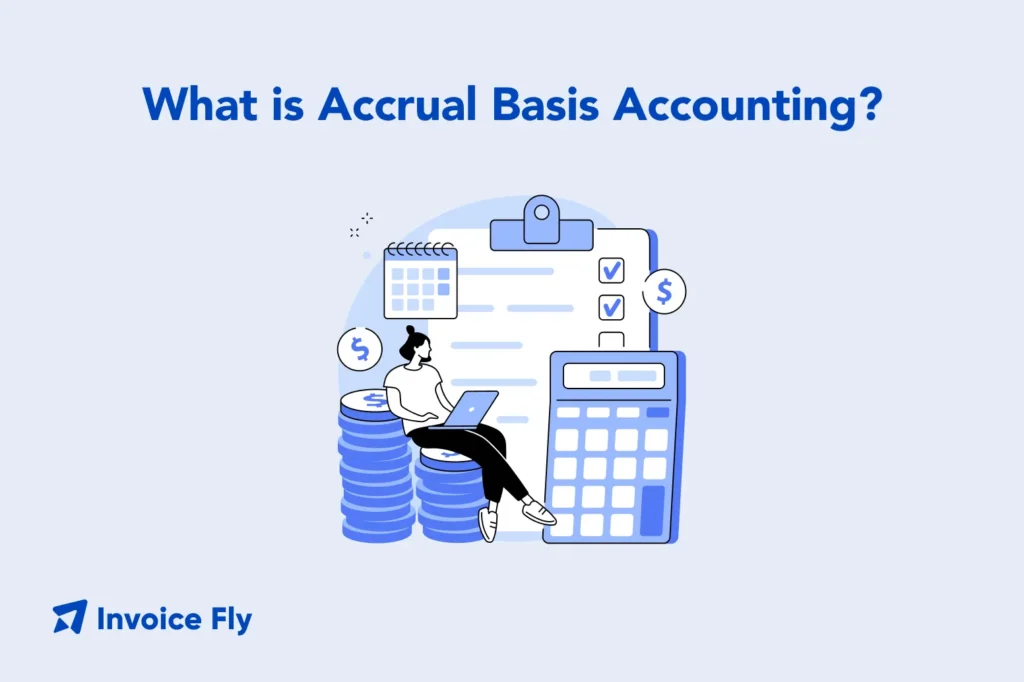What is Accrual Basis Accounting?

Table of Contents
- What Is Accrual Accounting?
- What is an Accrual? (Simple Explanation)
- How Accrual Accounting Works
- Prepaid Expenses vs. Accrued Expenses
- Impact of Accrual Accounting
- Recording Accruals
- Accrual vs. Cash Accounting
- Benefits of Accrual Accounting
- Accounting Method and Taxation
- How Do You Explain Accrual to Non‑Accountants?
- What Is the Difference Between Cash Accounting and Accrual Accounting?
- What Is Accrual Journal Entry?
- What Are the 3 Accounting Methods?
- When to Use Accrual Basis Accounting
- Is Accrual Accounting Right for Your Business?
- When to Use Accrual Basis Accounting
- Remember
- FAQs About Accrual Basis Accounting
If you run a small business or work as a contractor, understanding how your money moves is key to making smarter financial decisions. Accrual basis accounting is a method that records income when it’s earned and expenses when they’re incurred, regardless of when cash changes hands. This approach follows the accrual concept and gives you a true, period‑by‑period view of your company’s performance, which is crucial for planning, growth, and tax compliance.
In this guide, we’ll break down:
- How the accrual method works with real-world examples
- Key differences between accrual and cash accounting
- How it affects your bottom line, nonprofits, and business operations
- When small businesses should adopt accrual basis accounting
What Is Accrual Accounting?

Accrual accounting is the financial accounting method most businesses use to get an accurate picture of profitability. It follows the matching principle, which pairs income and related expenses in the same reporting period.
This method is part of Generally Accepted Accounting Principles (GAAP) and is often required by the IRS for businesses with inventory or revenues above $25 million.
How it works:
- Revenue is recorded when you deliver a product or service to the customer, even if you haven’t received payment yet.
- Expenses are recorded when you receive the benefit of goods or services, even if the bill hasn’t been paid.
Example:
- You finish a $5,000 landscaping job in December and invoice the client, but the check arrives in January. Under accrual accounting, you record $5,000 revenue in December.
- You receive building materials in June but pay the supplier in July. The expense is recorded in June because that’s when the materials contributed to your operations.
Accrual accounting produces financial statements that reflect true business operating performance, including cost of goods sold (COGS), operating expenses, and assets on the balance sheet.
For a full bookkeeping overview, read Small Business Bookkeeping.

What is an Accrual? (Simple Explanation)
An accrual is any earned revenue or incurred expense not yet received or paid. It reflects the economic reality of your business, not just cash inflows or cash payments.
Examples of accruals:
- Accrued revenue: A consulting firm completes a project in March, sends an invoice, and expects payment in April.
- Accrued expense: A contractor uses electricity for a February project but won’t get the utility bill until March.
Accruals are essential because they:
- Keep your income statement and balance sheet accurate.
- Help you spot future cash needs and incoming payments.
- Ensure compliance with accepted accounting principles GAAP.
For profit retention insights and how accruals impact equity, see our guide on How to Calculate Retained Earnings.
How Accrual Accounting Works
Under accrual accounting, every transaction is captured as soon as it impacts your business, not your bank account. There are two main categories:
1. Accrued Revenues (Assets)
Revenue is recorded when earned, often as accounts receivable.
Example:
| Date | Transaction | Amount |
| Dec 10 | Service delivered to client | $4,000 |
| Dec 15 | Invoice sent (payment Jan 5) | $4,000 |
This improves planning for cash inflows and shows your bottom line accurately.
2. Accrued Expenses (Liabilities)
Expenses are recognized when incurred, even if the cash account hasn’t been hit.
| Date | Expense | Amount |
| Jan 28 | Utility bill for January | $300 |
| Feb 05 | Payment issued | $300 |
Accrued expenses capture line items like materials, utilities, or payroll that affect business operating decisions.
Pro Tip: Use an accounting system or ERP to automatically create these journal entries, reduce human errors, and simplify review and approval.
Prepaid Expenses vs. Accrued Expenses

- Prepaid expenses: Payments made upfront for future benefits, like six months of office rent, annual insurance premiums, or advance maintenance contracts. These payments are recorded as assets on the balance sheet because they provide value over time and are gradually recognized as an expense when used.
- Accrued expenses: Obligations your business has already incurred but not yet paid, such as utility bills, wages, interest, or vendor invoices awaiting payment. They are recorded as liabilities because they represent amounts you owe.
Understanding this difference helps avoid errors and ensures your financial information is actionable. Prepaid expenses highlight what value is still to be consumed, while accrued expenses reveal upcoming cash outflows.
Recognizing both correctly supports budgeting, cash‑flow forecasting, and compliance with generally accepted accounting principles (GAAP).
Impact of Accrual Accounting
Accrual accounting affects all major financial reports and has a direct impact on how you understand your company’s performance over time.
It provides a comprehensive picture for managers, lenders, and investors because it doesn’t just show cash activity — it shows the true economic activity of the business.
- Income Statement: Shows revenue, operating expenses, and goods sold COGS in the correct period. By aligning income and expenses, you get a clearer view of profit margins and your bottom line.
- Balance Sheet: Includes accounts receivable, accounts payable, prepaid expenses, and long-term assets. This tells stakeholders what you own, what you owe, and how well your business operating activities are converting into equity.
- Cash Flow: While cash timing isn’t the primary focus, accrual accounting informs cash‑flow forecasting. By understanding which line items will become cash inflows or payments soon, you can plan for growth, handle seasonal fluctuations, and avoid liquidity issues.
Example:
- Identifies late‑paying clients early, so you can follow up before it affects operations.
- Helps estimate business operating profitability more accurately than cash accounting.
- Supports informed decisions for loans, credit lines, and investments because financial statements reflect economic reality.
- Highlights upcoming obligations like taxes or vendor payments, helping ensure you have adequate cash on hand.
Recording Accruals

Recording accruals involves making journal entries that affect your line items and bottom line:
Accrued Revenue Entry:
Accounts Receivable $5,000
Service Revenue $5,000
Accrued Expense Entry:
Utilities Expense $300
Accounts Payable $300
Best practices:
- Reconcile monthly to ensure cash accounts match upcoming obligations.
- Use automation to reduce time‑consuming manual processes.
- Convert accruals into invoices or payments promptly to improve cash inflows.
When learning to create invoices and manage receivables, explore our guide on what is an Invoice?
Accrual vs. Cash Accounting
Cash accounting methods differ, and the cash basis method is considered the simpler option. This method focuses solely on recording cash as it enters and leaves your business, making it straightforward for small business owners to grasp.
It is ideal for operations with limited transactions or those who want to see immediate cash inflows and cash payments without tracking receivables or payables.
Cash basis accounting:
- Simple to manage
- Only tracks cash inflows and cash payments
- Can misrepresent profit when invoices or bills are pending
Accrual basis accounting:
- Recognizes revenue and expenses as they occur
- Complies with GAAP
- Gives a truer picture of your bottom line
Additional reading: IRS Publication 538 explains when cash vs. accrual is required for small businesses.
Benefits of Accrual Accounting
- Presents accurate financial information for decisions, budgeting, and taxes, giving stakeholders a realistic view of performance
- Aligns products or services revenue with operating expenses and COGS, improving profit analysis
- Essential for obtaining financing or attracting investors because lenders and backers rely on GAAP-compliant statements
- Facilitates long‑term planning and forecasting by showing when future cash inflows and obligations will arise
- Helps identify trends in line items, such as slow‑paying clients or recurring expenses, allowing for better business operating strategies
- Supports compliance with generally accepted accounting principles (GAAP) and provides credibility for audits or regulatory reviews
Need a reliable invoicing tool to manage accrual entries and get paid faster? Try Invoice Fly’s Invoice Maker — create invoices, track line items, and manage cash inflows in one place.
Accounting Method and Taxation
Accrual accounting isn’t just about accurate financial reporting—it also impacts how your business is taxed. The IRS may require accrual accounting if you:
- Maintain inventory or track goods sold COGS
- Earn over $25 million in annual gross receipts
By aligning income and expenses, you ensure that your tax reporting reflects true economic activity. Understanding tax implications helps avoid penalties and ensures compliance with generally accepted accounting principles (GAAP).
FASB and IFRS
The Financial Accounting Standards Board (FASB) and International Financial Reporting Standards (IFRS) both recognize accrual as the preferred method because it:
- Provides a clear, comparable financial picture
- Supports investor confidence and lending decisions
- Meets audit and regulatory standards
How Do You Explain Accrual to Non‑Accountants?
You can explain accrual accounting as: “Recording revenue and expenses when the work happens, not just when the cash moves.”
Simple analogy: If you finish a job today but get paid next month, accrual accounting counts today’s work as revenue. This approach is vital for contractors, service providers, and anyone managing goods and services over time.
What Is the Difference Between Cash Accounting and Accrual Accounting?
- Cash accounting records activity only when money enters or leaves your cash accounts.
- Accrual accounting records products or services and expenses in the period they are earned or incurred.
Understanding this difference helps businesses choose the right method for growth and compliance.
What Is Accrual Journal Entry?
An accrual journal entry records revenue or expenses before cash is exchanged.
Example:
Accrued Revenue:
- Accounts Receivable: $2,500
- Service Revenue: $2,500
Accrued Expense:
- Wages Expense: $1,000
- Wages Payable: $1,000
These entries keep your financial information accurate and compliant with GAAP.
What Are the 3 Accounting Methods?
- Cash Basis Accounting – Simple, only tracks cash moving in and out.
- Accrual Basis Accounting – Matches revenues and expenses to the periods they occur.
- Modified Cash or Hybrid – Combines elements of both for select transactions.
When to Use Accrual Basis Accounting

- When your business manages inventory or has significant receivables/payables
- When applying for financing or attracting investors who require GAAP statements
- When you need accurate long‑term assets and bottom line insight for planning
Is Accrual Accounting Right for Your Business?
If your operations involve goods and services delivered over time, multiple projects, or frequent invoicing, accrual accounting likely gives the clearest view of performance. It helps:
- Reveal the real bottom line
- Prepare for taxes and audits
- Build trust with lenders and investors
Smaller businesses with very simple transactions might start on a cash basis and switch to accrual as they grow.

When to Use Accrual Basis Accounting
- When your business manages inventory or has significant receivables/payables
- When applying for financing or attracting investors who require GAAP statements
- When you need accurate long‑term assets and bottom line insight for planning
Remember
Accrual basis accounting gives you a realistic, comprehensive view of your finances. By recognizing revenue and expenses when they occur rather than when cash changes hands, your financial information becomes more reliable for decision‑making, planning, and reporting.
Ready to take control of your invoicing and stay on top of your finances?
Try Invoice Fly’s Invoice Maker — It’s free!
Create professional invoices, manage line items, and track payments with ease.
FAQs About Accrual Basis Accounting
Records revenues and expenses when earned or incurred, not when cash moves.
Cash basis tracks only cash accounts, while accrual matches revenues and expenses per period.
Completing a $2,000 good or service in December but recording revenue before January payment.
It captures obligations and earnings in real‑time, improving financial information and forecasting.
- Accrued revenue
- Accrued expenses
- Deferred revenue
- Prepaid expenses
